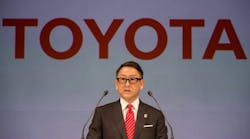Toyota Cuts Production Costs to Allow Record Research Budget
The knives are out on costs at Toyota Motor Corp.
Asia’s biggest automaker saved 100 billion yen (US$875 million) in the half year ended September through measures including the continued roll out of a new manufacturing process. That’s more than $3,300 every minute in those six months.
The money saved will help bolster spending on research and development to a record 1.06 trillion yen this year as President Akio Toyoda pushes the company deeper into new electrified powertrains and artificial intelligence, areas he says the automaker needs to lead.
Aggressive cost cutting, a weaker yen and continued dominance of the Japanese market led Toyota to raise its full-year profit on Nov. 7 and announce a share buyback.
“We not only need to develop these leading technologies but also need to commercialize them,” said CFO Osamu Nagata. “In order to do that, we need to increase R&D expenses. This will be a cost burden so we need to speed up cost reduction.”
Toyoda had earlier set up a task force comprising four executive vice presidents, including Nagata, to ensure new spending is funded by cuts in other programs.
Japan’s biggest automaker predicted operating income in the year ending in March may be 2 trillion yen, up from the 1.85 trillion yen forecast in August. The improved forecast signals Toyota may avert a second consecutive annual profit decline, a landmark that last happened since 1994 and something Toyoda has vowed to prevent.
A weaker yen is providing a strong tailwind, adding 175 billion yen to projected operating income. Toyota now sees the yen averaging $111 and 128 per euro over the year to March, from $110 and 124 seen in August.
First-half group operating income declined about 2% from year earlier to 1.12 trillion yen CFO Nagata said the decrease was mainly on account of marketing expenses Nagata hopes to improve profitability in the second half and next year after increasing production capabilities of SUVs, pick-ups that are doing well Camry to contribute to profitability in North America Toyota to continue with share buybacks to improve capital efficiency
While Toyota joins Honda Motor Co. in raising annual profit forecasts, Subaru Corp. cut its estimate for the fiscal year and Mitsubishi Motors Corp. maintained its numbers. Nissan Motor Co. is scheduled to announce its earnings Nov. 28.
Toyota warned that incentive spending and the continued customer shift toward trucks and SUVs is clouding the outlook for the U.S. market, the company’s biggest. Despite the caution, Toyota is on pace to sell more vehicles in the country this year than in 2016, even as the market heads for its first annual contraction since 2009.
In the three months to September, Toyota took a 15% share in the U.S. for the first time since 2009, outselling Ford over the entire quarter. Toyota’s RAV4 is the best-selling compact crossover in the country, and in July it introduced an all-new Camry, America’s best-selling car. The Camry is the first model from Toyota that has been redesigned from scratch around the new manufacturing process, which saves costs by using more shared parts across different vehicles.
Toyota is strengthening its presence in the U.S., joining with Mazda Motor Corp. to build a $1.6 billion auto plant in the country. The location of the plant is due to be decided early next year, with production beginning in 2021. As a consequence of the plan, Toyota reduced the size of its initial investment in a new Mexican factory by 30% to $700 million.
In January, President Donald Trump criticized the Mexican factory plan, demanding Toyota build a plant in the U.S. instead. Trump, who is in Asia this month, left Japan without a concrete agreement to address what he deems an unfair trade relationship between Japan and the U.S.
By Kevin Buckland and Nao Sano




